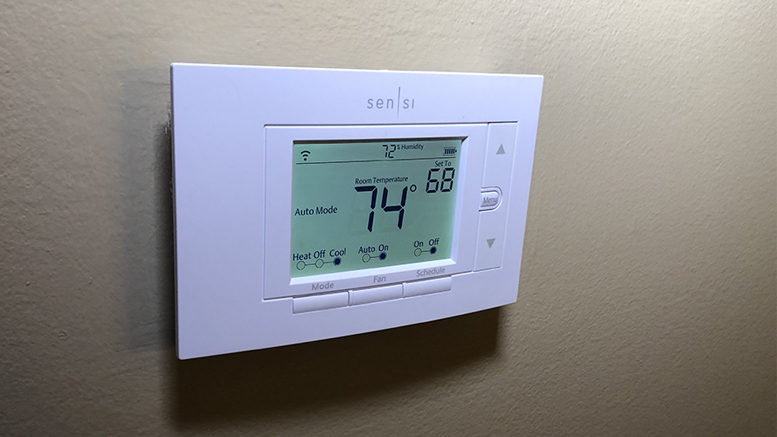By Indiana Michigan Power—
FORT WAYNE, Ind. – While this has been a warm fall, winter and colder temperatures will be here before we know it. In fact, this winter is predicted to be colder across the country compared to last year, which could mean higher heating bills. Now is the time for customers to prepare their home or business for the colder weather.
Indiana Michigan Power (I&M) is Powering the Next Energy Saving Idea during National Energy Awareness Month by offering tips to help keep energy costs under control this winter. The company wants to remind customers about this during National Energy Awareness Month, which encourages the government and companies to raise awareness of the importance of sustainability and managing the nation’s energy resources.
“Colder temperatures can make heating systems and water heaters work harder, which ultimately will impact a customers’ monthly energy bill,” said Heather Riggle, I&M’s Energy Efficiency Residential Account manager. “Indiana Michigan Power has a number of energy savings ideas, rebate programs and payment assistance programs to help customers have a safeand warm winter in their home or business.”
Winter Energy Saving Tips
Below are 10 tips to implement before cooler temperatures arrive.
- Set thermostat a little lower during winter months. A customer can reduce heating costs 2-3% for each degree of Changing the temperature from 72°F to 68°F could lower an energy bill by up to 10%.
- Change or clean the furnace filter once a month. Dust and dirt can quickly clog vital parts, making the furnace run harder and eventually break.
- Have the heating system inspected regularly. A $50-$100 annual tune-up can help reduce heating costs by up to 5%.
- Vacuum registers and vents Don’t let furniture and draperies block the airflow. Inexpensive plastic deflectors can direct air under tables and chairs.
- Safely repair and/or apply weather stripping to air leaks in the home. Up to 25% of energy used to heat/cool homes escapes via air leaks. Areas to check include dropped ceilings, recessed lighting, attic entrances, ducts, doorframes, electrical outlets and switches, window frames and plumbing/utility access.
- Check the outside of a home or building for air leaks. Look for leaks at the openings for water spigots, air conditioner hoses, dryer vents and gas pipes. Use caulk or expanding foam to seal spaces.
- If drafts sneak in under exterior doors, replace the threshold. If that’s not practical, block the drafts with a rolled-up towel or blanket.
- If a home or building has electric baseboard heating, keep furniture and draperies away from the It’sadvised to leave at least a three-inch clearance under the heating unit.
- If a customer has a wood-burning fireplace, have the chimney cleaned and inspected regularly. Burn only fully dried hardwoods to produce the most heat output.
- Take extreme care when using a space heater. Place it at least three feet away from anything that can burn, including walls, and unplug it before leaving a room.
For more winter tips and ideas please visit www.electricideas.com. There are more than 100 tips and ideas for customers tosave energy and possibly money.
Heating Assistance Programs
Beginning on Nov. 1, I&M customers in Indiana can apply for winter heating assistance through various local and state agencies and organizations. To apply, please visit www.IndianaMichiganPower.com/neighbor-to-neighbor and click on“Find an Agency.”
Flexible Payment Options
I&M has options for customers that include giving them more time to pay their bills, as well as setting up payment plans. I&M offers payment extension giving customers a few more days to pay their bill in full and extended payment arrangements that offer customers the ability to spread out payment over a few months.
Local and Federal Assistance
I&M works with many organizations to help customers find local and federal assistance. Customers can call 211, or visit IN211.org for Indiana or MI211.org for Michigan customers, for information about utility, housing, healthcare and many othertypes of assistance. They can also find a listing of local and federal assistance agencies on ElectricIdeas.com/Home.
Keep Informed
With fall and winter approaching, now is the time to get and stay connected with outage alerts and updates.
I&M’s forestry team works year round to cut and trim trees that threaten power lines, but sometimes, Mother Nature wins. Winter winds and heavy snow can topple trees, power lines and cause outages at homes and businesses. Knowing how toget in touch with I&M will save customers time in the months to come.
I&M encourages customers to use the Indiana Michigan Power app to monitor the status of any outage affecting your home or business. IndianaMichiganPower.com/App. You can sign up for text and email alerts on the app or at IndianaMichiganPower.com/Alerts. See the location and status of outages using our outage map atIndianaMichiganPower.com/OutageMap. For the latest updates please follow Indiana Michigan Power on Facebook and findus on Twitter @IN_MI_Power
Keeping information current, such as email addresses and phone numbers, is also important in staying connected. Please visit www.IndianaMichiganPower.com/Account to update yours.
ABOUT INDIANA MICHIGAN POWER
Indiana Michigan Power (I&M) is headquartered in Fort Wayne, and its approximately 2,100 employees serve more than 600,000 customers. More than 85% of its energy delivered in 2020 was emission-free. I&M has at its availability various sources of generation including 2,278 MW of nuclear generation in Michigan, 450 MW of purchased wind generation from Indiana, more than 22 MW of hydro generation in both states and approximately 35 MW of large-scale solar generation in both states. The company’s generation portfolio also includes 2,620 MW of coal-fueled generation in Indiana.



